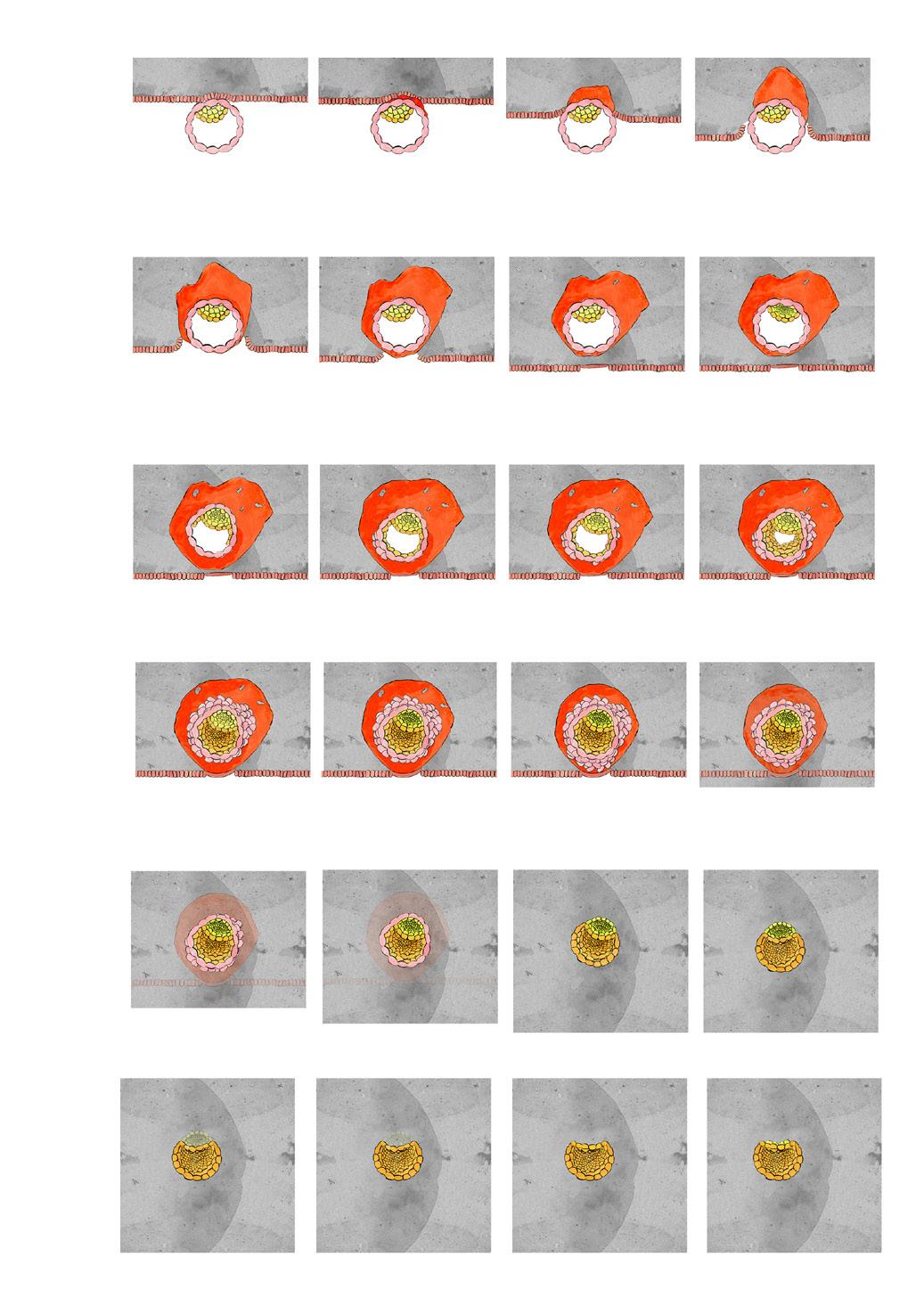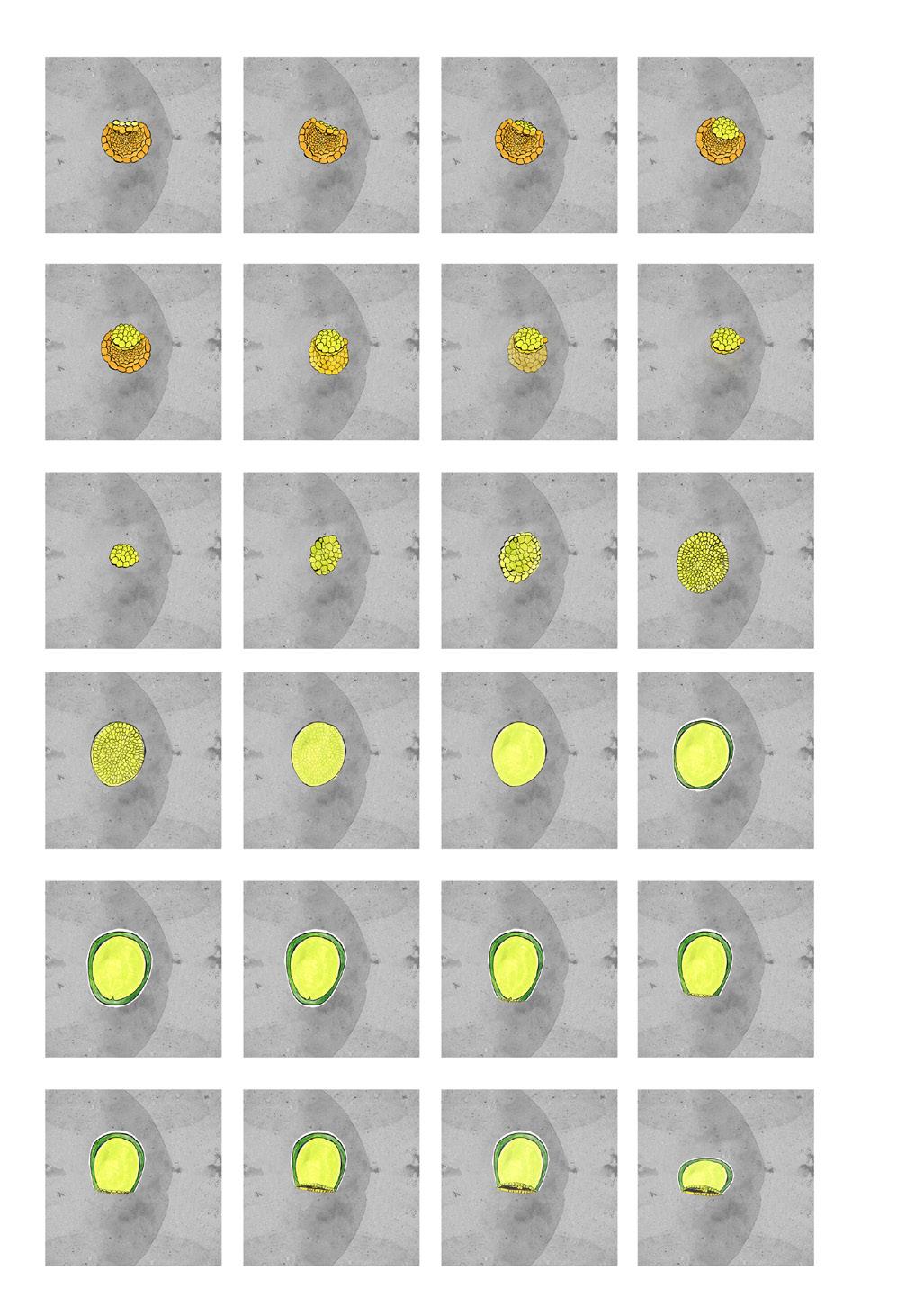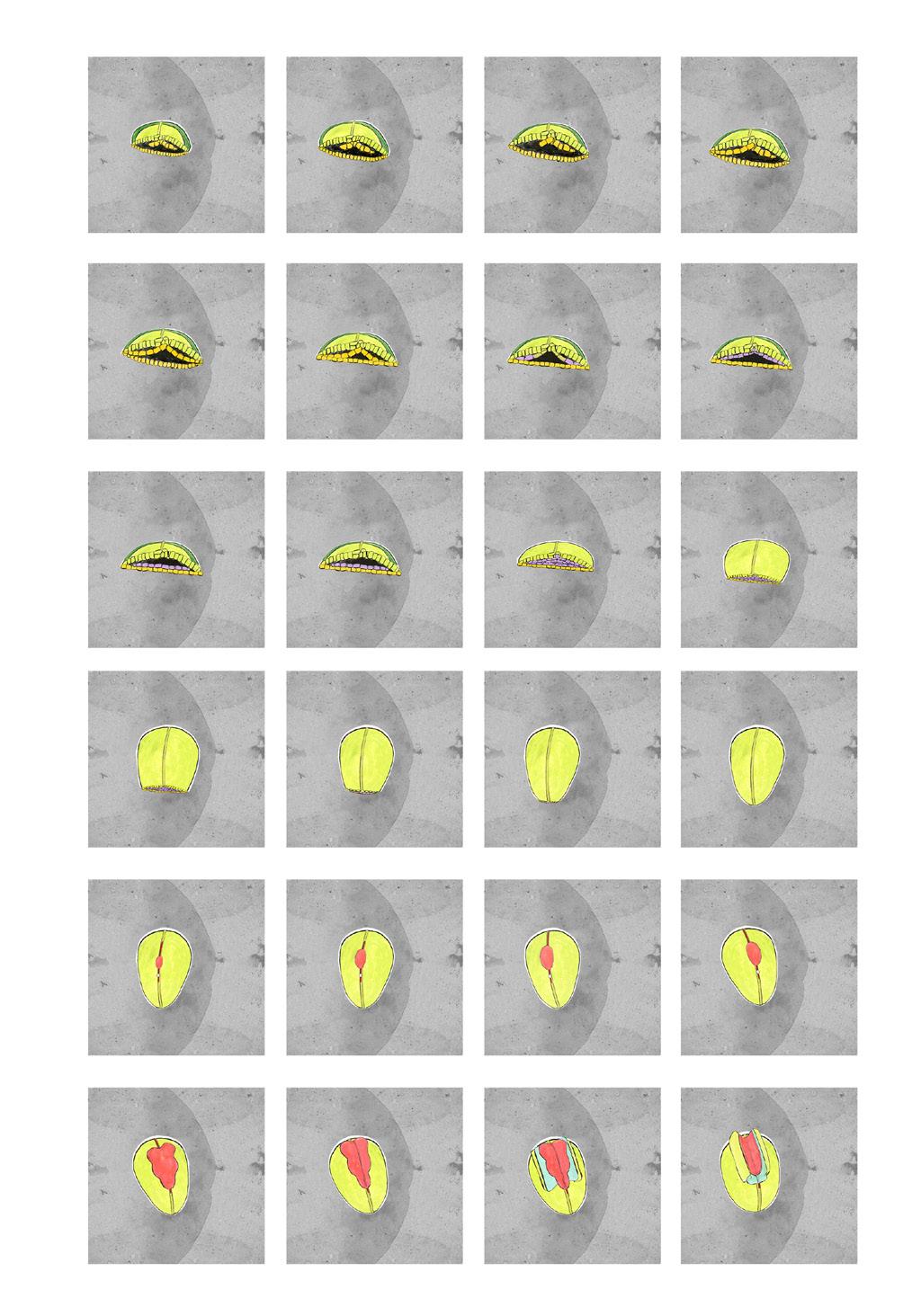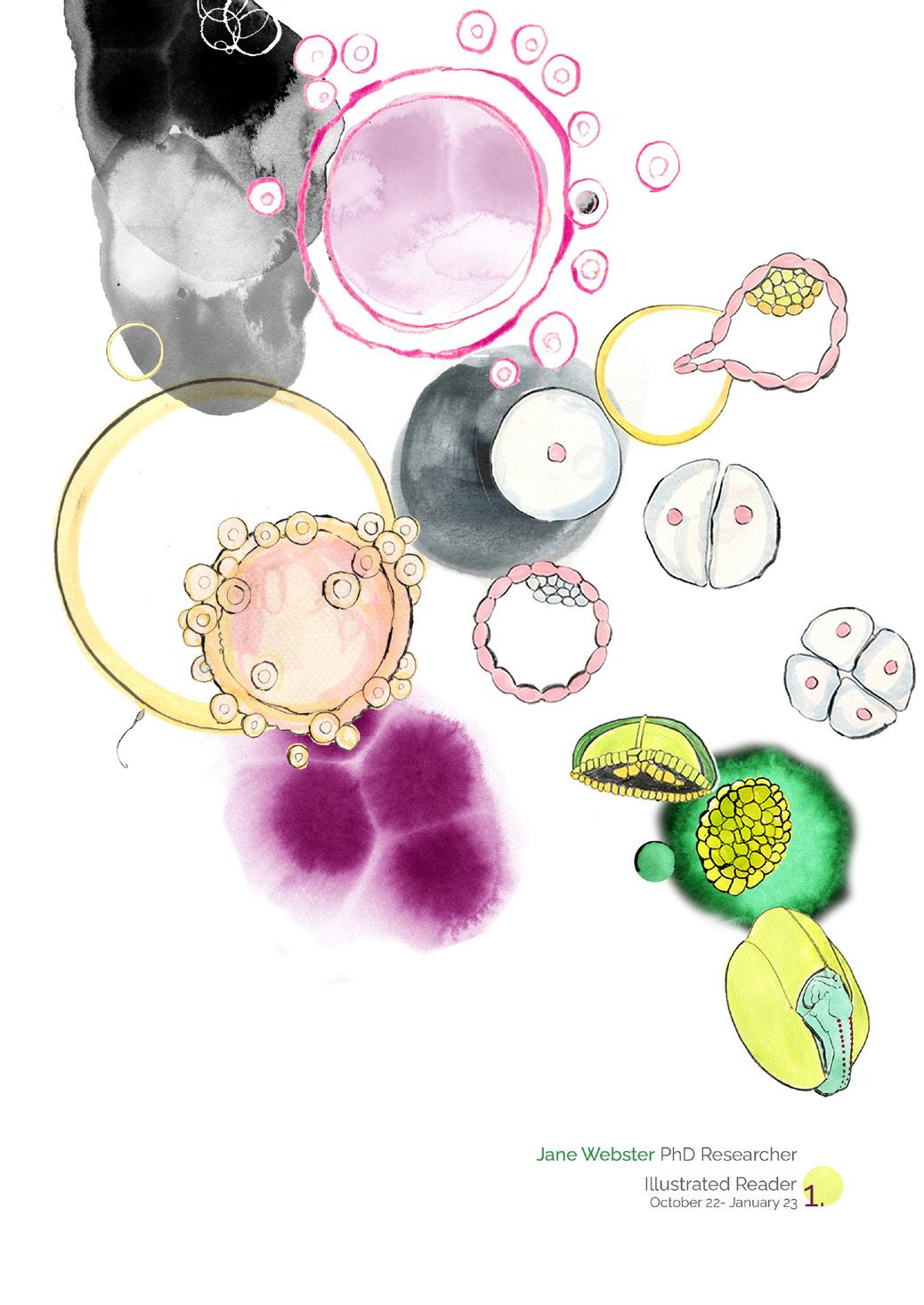
How can choice and confidence be encouraged in the experience for birthing Mothers through Illustration Animation practice?
“There is no such thing as a normal birth.” Emily McMorrow –Maternity Support Worker.
Working in collaboration with Specialists, Midwives and Maternity support workers at Kingston Maternity Unit, this research aims to document and evaluate how illustration animation practice, as a documentary research method, can acknowledge and communicate diverse perspectives of the childbirth experience. Then strive to offer new innovative interdisciplinary visual approaches to empower women to make informed decisions at all stages of the birthing journey.
Key to the development of this proposal has been attendance at ‘The Big Room’ bi-weekly team meetings at Kingston Hospital’s Maternity Unit with clinical staff. Experiencing these meetings has illuminated how childbirth often does not align with their initial expectations for many women. Pregnant women are encouraged to consider a detailed birth plan - to identify the birth location, agree pain relief options, who will be present at the birth and how they would like to hold and feed the baby post-delivery. However, many women experience their baby’s birth considerably differently from their ‘birth plan’, resulting in an unexpected story. There are a considerable number of factors that can determine the narrative of any birth experience pre, during and postpartum. Typical issues may include short staffing, induced birth, a change in the mother’s blood pressure, weight and gestational diabetes or health. Some complications or issues with the baby’s growth rate or heart rate condition. 1 in 10 babies requires additional help in the neonatal unit following a premature, complicated, or emergency birth story.
The unknown, and changes to an anticipated birth plan can dramatically alter a birth story and be frightening. This can result in a sense of failure or disillusionment for the new mother can have implications and associations with postpartum depression.
Practice-based elements for the project will utilise documentary drawing processes to improve understanding of the narratives, choices and the preparation needed for women giving birth by visually communicating the processes. The environment and equipment can provide a space for women and their support networks to experience the range or potential of choices in giving birth. It is anticipated this research can assist in improving rapid decision-making that is often required within the clinical setting to communicate complex information to women giving birth and their partners.
Visual representation would provide immediate communication, which potentially can cross language barriers and issues with reading ledgibility
KMU’s focus is on improving foetal maternal outcomes for all of their women. Staff report there is no visual language to communicate the stages and importance of foetal heart monitoring, what happens in the induction of a pregnancy, or the screening processes for gestational diabetes, amongst other procedures and protocols. Medical Illustration exists on the body’s physiology, but these do not communicate a narrative and are not necessarily patient-orientated in the tone of the visual language.
Drawing-Documentary drawing is a powerful method to share knowledge and to create a hierarchy of information for the viewer. It is a form of visual journalism, where the illustrator captures and records events as they develop. The reportage or documentary practitioner’s premise is that of a storyteller or a narrator of the experiences unfolding at that location or event. As a visual form it has a unique facility to edit, select and focus upon the part of the story that requires attention at a particular point in time. This project will be based in drawing on location at the hospital, then developing those drawings in the studio to develop them through time and animation process. Giving birth is a time based event, encompassing several stages, developments, and transitions. We respond to drawing in a wholly different way than we visually identify with the photographic image. Historically this drawing practice made sense of ritual, places, and events of time. This project will be rooted in the practice of visual journalism for education purposes.
Documentary or reportage drawing does have standard links with photography and filmmaking. However, the unique aspect of documentary drawing is that the narrative communicates through the hand of the illustrator. The live, immediate, eventbased process of recording an event can provide insight into which words alone fall short. Through the choice of the drawing medium and aesthetic decisionmaking, documentary drawing has a language that can be articulate across spoken language.
The documentary illustrator has the facility to edit, select, and focus on the momenthat needs clarification so that the viewer, in this instance, the patient, can better understand the experiences or the choices available to her. Drawing can spotlight or delineate the complexity of an event, location or action. A visual information hierarchy can allow the audience to process and understand what they may experience.
In return, she potentailly feels more prepared and aware of the range of options for her particular birth story.
Context: in practice, in research and theory:
The Birth rites collection is the first and only contemporary artwork collection dedicated to the subject of childbirth. Through the presentation and dissemination of the work in the public domain, BRC encourages debate and increases awareness around childbirth practice. Issues like the shift towards medical intervention in birth and explores the impact of biomedical advances in technology. They explore whether society’s focus on propelling women on to an equal footing with men in the workplace, erodes their importance as mothers and investigate how women are able to give birth in a way they want.
https://www.birthritescollection.org.uk/
For nine years, this organisation has been building a big chain of birth stories. The link gets longer all the time, so if you’d like to add to it, please get in touch. Whether a waterbirth or caesarean, induction, or a breech birth or home. Parents are encouraged to share their stories to support others – especially new parents.
http://www.tellmeagoodbirthstory.com/
NOOR ALBAKER — Glasgow School of Art School of Simulation and Visualisation
Foetal beat: the development of interactive 3D digital models and animation of the heart as a comprehensive digital source for anatomical and medical education.
SUZY ROAN — Glasgow School of Art
School of Fine Art
Counter-narratives of childbirth in the UK: developing visual languages of embodied birth through expanded drawing practice.
MERLIN EVANS is an educator, writer and artist, director of ‘Drawn to Medicine’ she specialises in the complexities that makes us human through drawing and live performance work.
Methods: specify the various methods you are going to use to answer your research question. and meet the project aims
The interviewing of staff at KMU. What are the barriers to communication with expectant mothers? What expectations fall short? The four stages of birth- How can the stages of the birth experience be better framed and understood so patients are better prepared when a birth plan requires changes or intervention. What are these interventions? and what is unclear? Who are their patients? What do they need regarding the level of engagement
and understanding of their pregnancy and possible birth experience?
The Big Room- Attending the weekly Friday meeting where staff from all roles of the Maternity Unit come together to reflect, plan, and improve their services and the experiences for their women. A case study is presented and discussed where staff from all unit roles can offer commentary and experience the range of pressures each encounter and how measures can be taken to improve their experience.
The attending of Susanna Pereria’s baby Lifeline training sessions CTG Cardio (Heart) Toco (Uterus) Graph master classes. She reports there has been a well-documented need for multi professional improvements to CTG interpretation for decades to improve neonatal and maternal outcomes. Errors with fetal heart rate monitoring was the most common theme found in Five years of cerebral palsy claims:
A thematic review of NHS Resolution data (2017).
NHS England (NHS England, 2019, 2016) recommends effective foetal monitoring in labour as one of the key elements of care designed to tackle stillbirth and neonatal deaths. These courses aim to provide evidence-based training on CTG interpretation based on foetal physiology and pathophysiology of intrapartum hypoxic injury so as to reduce hypoxic ischaemic encephalopathy whilst reducing not necessary operative interventions.
The interviewing and listening to women in the first, second and third trimester of perceived preconceived birth experienes. What do women expect? The questioning of new mothers, what do they feel, required clarity? What was that experience, and did they feel prepared? What could have enabled them to feel more prepared?
Documentary drawing, and observing a range of birth stories, including low risk spontaneous vaginal birth, assisted instrumental delivery with forceps and vontous. Breech birth, Higher risk birth –women with hypertension, pre-eclampsia, gestational diabetes, raised BMI. Planned and emergency Caesarean Section birth. Multiple birth pregnancy. The recovery after birth stories. The neo-natal unit. Was that experience as expected? Was it good,bad, disappointing, surprising, shocking, fanastic disempowering, delusional, failed, feeling left feeling cheated or grieved?
Reflecting- how can the stories be told from the perspectives of the clinical team and the woman. What is the depth of
information for the demographic of their patients? What do they require?
Design -how can this information of verbal, clinical, aural and drawn experiences be communicated to explain and empower future mothers and encourage understanding of clinical language. Where the potential placement of this design exists and in which form.
Testing- introducing visual communication to KMU. How does the material work in clarity and accessibility, and does it translate and bridge the gap between medical terminology and expectation?
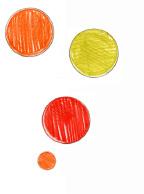
Reflective Practice- The analysing and critically reflecting upon the work. What can be made more transparent, and how can be it be improved? Can it be applied to other medical processes and procedures or communities?
Ethics:
Ethics will play a vital role within this project and informed consent is essential. The intention of research will be made clear through a written statement and outline of the project. Informed consent forms will be draughted for all women to agree to being interviewed. Recorded in a written or a recorded form. To be drawn and any drawing that has a recognisable aesthetic be agreed to be part of any public outcome. I will be applying for NHS ethical clearance
Potential outcomes and impact:
The research sets out to create a visual method for expecting mothers to understand the maternity environment better. Familiarising women with what the unit itself looks like. The visual language of specialist equipment and rooms. How is a baby monitored? Which possible intervention(s) be experienced? The beneficiaries are from both sides of the experience. The clinical and care providers will have a visual translation of what birthing mothers expect and understand of their birth narratives. Through illustrated animated language, the patients will have a clearer understanding of the types of birth story they may encounter. I propose that the outcomes for the research can be easily accessible and not have print costs. To be accessible in the clinical setting to bridge the gap of verbal information and be used as a tool where language is a potential barrier.
“From an improvement perspective, we heavily promote visualisation as a means of influencing behaviour. This might be about using visualisation to communicate data more effectively, or visualising
“From an improvement perspective, we heavily promote visualisation as a means of influencing behaviour. This might be about using visualisation to communicate data more effectively, or visualising instructions and process flows to help people carry out a task to a particular standard in a consistent way. This links closely with heuristics, human factors or behavioural science: how do we make it as easy as possible for people to do the right thing in a given situation, particularly when they may be very busy or fatigued.’
“Well-designed visual aids tend to be highly effective tools for improving informed decision making among diverse decision makers.”
Quote from Jon Grellier Kingston Hospital’s Head of Improvement
Designing Visual Aids That Promote Risk Literacy: A Systematic Review of Health Research and Evidence-Based Design Heuristics
Rocio Garcia-Retamero, Edward T. Cokely



28.03.06
Jonas MorlandSummer 2022, Norway Arendal. I am looking at a picture of a woman holding a brand new baby in the Spring of 2006. She is staring lovingly into its shiny new little face. Its eyes are locked in a hopeful, expectant gaze. That woman is me, and she’s thinking, ‘Shit, shit, shit, what have I done?’ She is knackered and terrified about keeping it (the baby) alive and the fact she maybe has euthanised her illustration career. The baby is a boy. He is lovely - perfect, apart from the mid-line abnomality on his neck. It appears as an angry red raised scratch, an open sinew hole beneath his chin, in line with his tiny collarbones. There were another two on either side that led nowhere. Selfishly we considered that we were lucky - it’s not on his face, as many mid-line or ventral issues present as a cleft palate or a ‘hair lip.’ A ventral abnormality is often an arrow to heart issues too.
*A ventral or midline abnormality can be best described as a defect that occurs on a body’s anterior (front) portion, usually in the middle or centre of the body.
Baby Webster Morland, 7lbs 8oz vaginal delivery 01.35 am on the 28th March 2006. He was due on 8th March. Feeling pretty in touch with a perceived reality of what first-time motherhood would be, I knew that babies don’t arrive on their due date. I’m sure mine would do me the service of turning up early, rocking the curve and getting me on this journey, hitting the ground running.
I loved being pregnant, feeling all-powerful, and obsessed with the physiological development of this tiny new person. I’m growing eyeballs in me, extraordinary! fingernails are ready this week -wow! Etc etc. With everything prepared for the 8th, another week rolls on, and the next. It’s the 22nd March now, is the placenta still working? Doesn’t it run out at 40 weeks? See- I am so informed and think I know what will happen as this first-timer. Many trips up and down to the G.P. and the maternity unit. Do you want to have a sweep? What the hell is a sweep? Try curries, sex, pineapple or any other nonsense offered up on Google.
*A membrane sweep is a standard procedure performed after 39 weeks of pregnancy to induce labour naturally. It’s performed by a healthcare provider and involves them inserting gloved fingers into your cervix to loosen your amniotic sac from your uterus.
It’s the 25th; you must be induced. What’s that?
Induce. /ɪnˈdjuɪs/ Meaning to succeed in persuading or leading (someone) to do something.
Ok, we’re to persuade this baby out. How does that work? Do we offer encouragement with the promise of a top-of-therange pram that could match the price of a second-hand car? The ‘Induction’ process involves starting artificially in induced labour or induction. It involves mechanically opening your cervix, breaking your waters, using medicine to start your contractions — or combining both methods. Hence, the birth plan is out of the window.
*A birth plan is a record of what you would like to happen during your labour, and your midwife can help after the birth.
I have failed and haven’t been in the maternity unit yet. I am admitted Sunday 25th. ‘We’ll start with another sweep. The third sweep doesn’t work. We are going for a pessary which will ‘ripen’ my cervix with a hormone called prostaglandin. References to fruit are prevalent in all women’s reproductive health care. ‘Try and get some sleep, and you can meet your baby in the morning.’ 5 am - stripping the membranes, a finger is inserted back and forth to separate the thin membrane connecting the amniotic sac (which houses the baby and amniotic fluid) to the uterus wall. We will pop you on a drip to speed things up at 9 am. A cannula or cannulas are put into the veins so fluids can be put straight into your bloodstream. This drug is Oxytocin and is given continuously through an IV drip. It is started in a small dose and then increased until your labour progresses well. Contractions start, and it is beyond any expectation of pain. Induced labours are more painful than spontneous labour as your body isn’t ready to make the necessary chemicals. We are going to break your waters now. Ok, how? This large crochet-like hook may be a little bit uncomfortable.
I weigh 95 kg. I am enormous, so positioning the super-scaled version of me requires two midwives and my husband— dignity dropped off on the umbrella stand at the maternity unit’s entrance.
This procedure feels like the hook is aiming much further than my cervix. It is undoubtedly ‘uncomfortable.’
Oh my God! I am not going to this drugfree! Hold on; I’m already full of drugs. The gas and air are doing nothing. Epidural, please! I was lucky as an anaesthetist on call and in the maternity unit. A small tube between vertebrae L3 and L4 is inserted, and pain relief is injected into the space, blocking any pain reception.
This procedure and drug are the best thing ever invented, and I hope they are in receipt of a Nobel prize for this or the equivalent. I resume from a writhing mess; I’m asking for the crossword to be passed across the bed. I am going to smash this. The day drags on, new midwives and more centimetres measured with fingers, 12 hours- still three cms: Eastenders, News at 10. We roll into the 28th. Was Ceefax a thing still there?
More epidural top-ups encouraged very blurred vision and a lot of vomiting. The husband is excellent at catching the projectiles in those strange cardboard upside -down top hats. Why has none mentioned most women vomit through their labour?
“I will tell you the great news that you are ready to push as you have met the magic number of 10 cm dilated.” Finally, it’s time to push. I was oblivious that labour was in different stages. is the ‘active stage.’ I’m unsure what I have been doing for the last 100 hours?
When you have an epidural you can’t feel when the contractions are- which is excellent but confusing for your body. *(Please can this be normalised in all delivery communication.)
The next and most brilliant midwife comes on at midnight. She’s perfect and has the focus of a sports coach, yet she is kind and sparkly. Come on, Jane! We must use an intervention if we don’t get this baby out. My legs are in stirrups; I can’t see anything now due to the drugs, but that’s fine, as the lovely Rebecca has taken over the jouney. ‘Think of everyone who has ever annoyed you in this next push.” She’s a genius! Her hand is inside my body- I love Rebecca. There is a list of names, family, bad boyfriends, and the odd work colleague.
Do you want an Episiotomy? What’s that?
*An episiotomy makes the opening of the vagina a bit wider, allowing the baby to come through it more easily. During childbirth, a doctor or midwife will cut the area between the vagina and the anus (perineum).
What will happen if I don’t have it? You will tear, and it is much more difficult to sew up. I will go for the first option.
A lovely baby came out. He went back and forth to St. George’s to ensure the midline issue wasn’t a marker for a heart abnormality. We were lucky, and it wasn’t. Kingston Hospital Maternity Unit provided us all with the most excellent care. We took him home in a car seat, sat him on the lounge floor and looked at each other thinking
- Shit. What do we do with him now?
13.09.09
Elsa Morland
Born at 33 weeks. After a full placental abruption. She spent a month in the neo natal unit. Elsa was supported by the incredible staff after being delivered in 58 minutes from being woken up by my three year old. A 999 call, paramedic assessment, an ambulance journey, maternity examination, theatre preparation and an emergency section. She was cooled and as a result the NHS care, she was healthy and without a brain injury
CPAP Hat -This keeps the CPAP machine secure and comfortable on the baby’s head.
CPAP Hose -This delivers air to the face mask through your baby’s nose
CPAP -Continuous Positive Airway Pressure- This delivers air to your baby to keep the lungs open and allow them to develop fully
Needle Free BungThis allows medicines to be given into the IV, such as antibiotics
Intravenous DripThis delivers fluids to your baby, directly into the bloodstream
Orogastric Tube FeedingThis is when your baby is fed through a small soft tube, which is placed in the mouth and runs down the back of the throat, through the oesophagus into the stomach
Y-Tubing- This is a type of IV where blood can be infused through one side and saline through the other

SECAC 2022 Watershed Conference.
Presentation of my PhD Proposal Friday 28th October 2022.
SECAC is a national non profit organisation devoted to educationd research in the visual arts. Founded in 1942. SECAC provides advocacy and support for arts professionals and engenders opportunities for the exchange of scholarship and creative activities through an annual conference and publications.
Initially founded as an organisation of artists, scholars, and arts professionals from the southeastern states, SECAC has grown to include individuals and institutional members from across the United States and around the world. It is now the second largest organisation of its kind.
*(Re)Framing the Subject: Unexpected Revelations in Portraiture
*Makerspaces: Developing A Cross Disciplinary Space

*Art, Ecology, and Environmental Catastrophein the Americas – (Floods, Fogs, and Toxins)
*Fostering Intellectual Curiosity
While Preparing Students for Industry Demand
*The Ruralness: Queer Narratives and Creative Practice Outside of Urban Centres –
*Belonging: Embracing Inclusivity and Diversity in the Graphic Design Classroom
*Early Modern Women and Artistic Production, Patronage, and Consumerism
*Home: Place and Belonging Early Modern Women and Artistic Production, Patronage, and Consumerism –
*Self-Adjacent: Negotiated Subjectivity in the Expanded Field of Parenthood
*The Pandemic: What Held Design Students Back? What Catapulted Them Forward?
*The Current State and Future Directions of Illustration
*This Is How We Do It: Making Methodologies for Social Change
Places to avoid in downtown Baltimore.One street looks absolutely fine, the next is straight out of ‘The Wire.’ Uber drivers would wait 10 seconds for a pick up.
 Characters from the American Visionary Art Museum: not dissimilar from the people I was staying near.
Characters from the American Visionary Art Museum: not dissimilar from the people I was staying near.
Birth Stories: Conference Paper
Developed from the PhD interview visual presentation. Presented at SECAC.

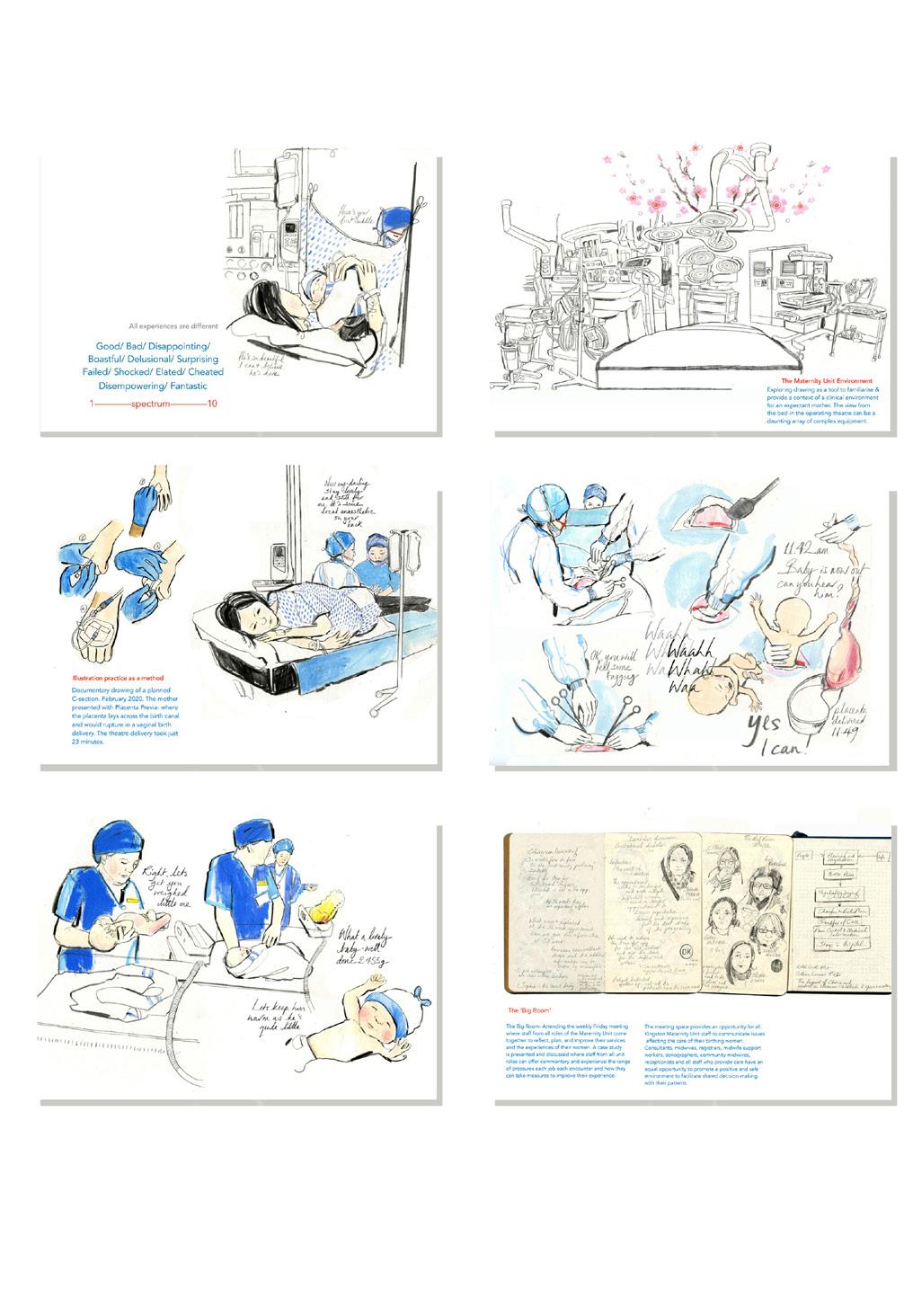


SECAC in Baltimore, MD. October 26-29.
The conference was informed by the theme‘Watershed,’ It sought to foster intersections between art, art history, education, social and environmental justice. To that end more than 130 individual sessions were presented. Here are the visual notes from the sessions I attended. The American model for teaching illustration feels very different in the delivery we offer students here is the U.K. Illustration Animation as a hybrid course is just at the start of being explored as a course structure in the United States. The two are separate as subjects for students to ‘major’ or to ‘minor’ in.
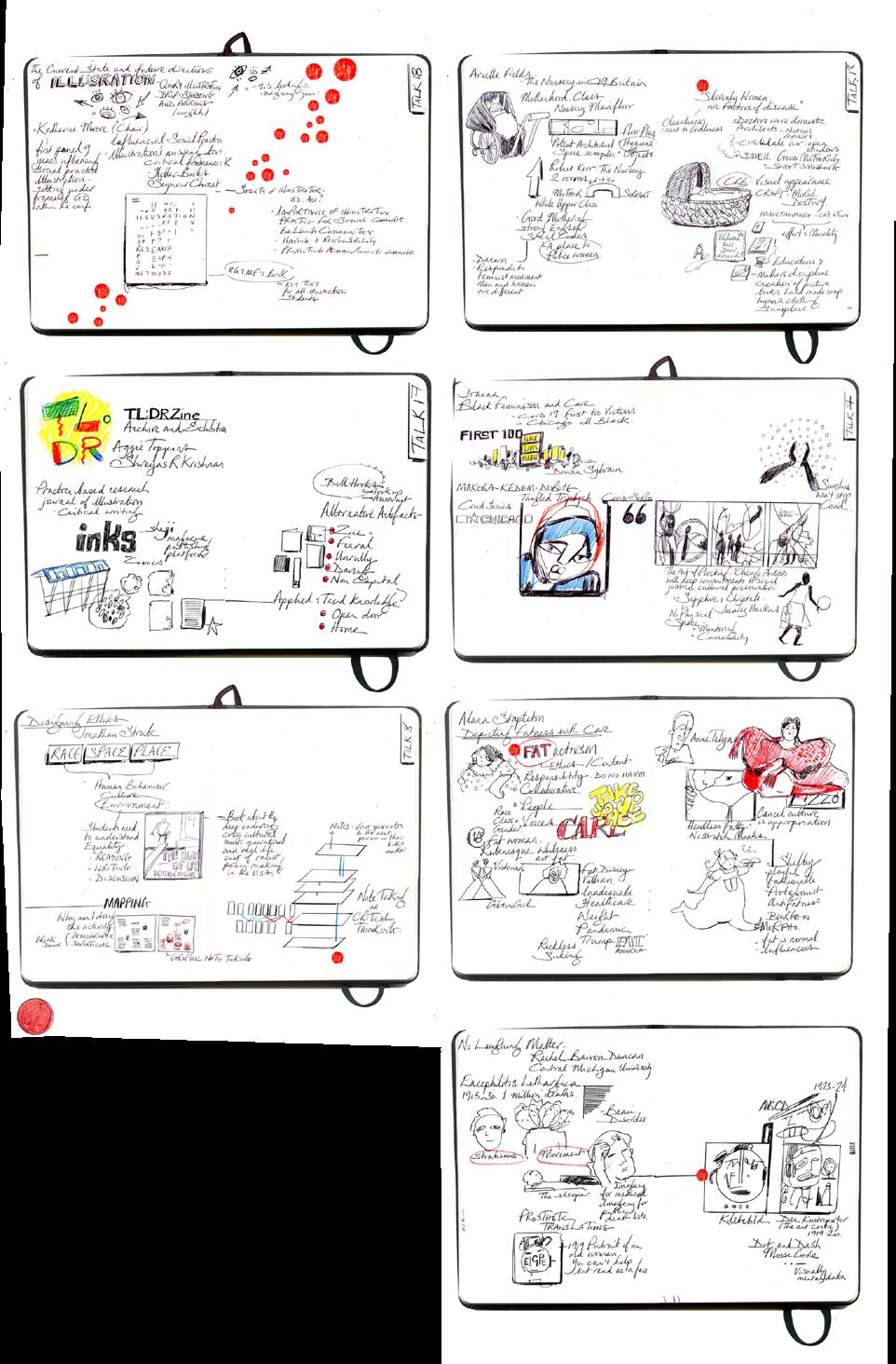

Waterstones Bookshop Piccadilly London
There are over 500 titles in the pregnancy and baby section of the bookshop. Here is a rough diagram of the themes covered in the space allocation and the order that this extensive section is displayed in. Note the range of reading material for Dad’s and about play!

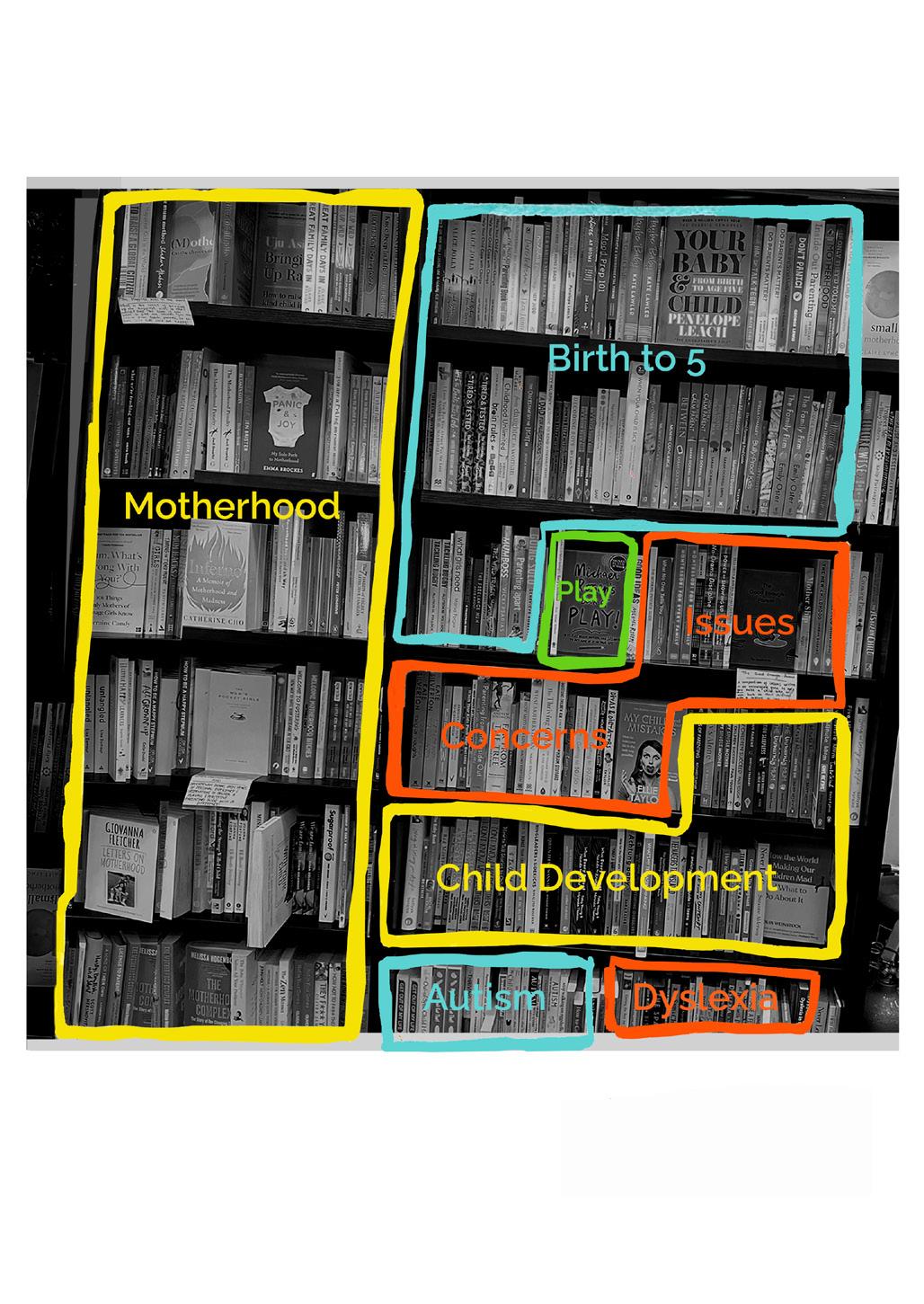
Motherhood
A Manifesto 2021
Eliane Glaser writes a book that explores the guilt, drudgery and the responsibility of child rearing. ‘Its the most important job in the world.’ According to anyone’s opinion in a public park. So why isn’t it paid? Where is the public recognition?
Glaser explores these questions through her rigorous book, including the many facets of giving birth and the enshrined birth plan and the notion of what agency women have in childbirth. The effects of not being listened to and the consequences that has on different women of different demographics. Her book analysis the historic and contemporary injustices of motherhood. The ‘notes on references’ section provides an excellent reading list of historical articles, memoirs and experience. She cites every book and magazine article that has gone into the research of her book. Pointing out the range of view points that contradict very aspect of motherhood. How we are ‘Dammed if we do, and dammed if we don’t. She also points out numerous resources that will benefit the research journey I am on, from birth trauma to tocophobia, geriatric motherhood, pay issues, how the NCT bench march is completely unachievable and not a credible way to live. We are bullied and guilt tripped, then asked to reign in our ambitions and get on with it without the right support.

A life’s work
On becoming a mother 2001
I read Cusk’s book whilst pregnant in 2005. At the time I was appalled by her acerbic honesty regarding the tedium and relentless of early motherhood. It can’t be that bad? She’s probably a terrible person? This was the way I nervously navigated the pages of grief for her freedom lost. The boredom of the long days, but short years that spill out in a new monotony of existing. I have since re-read her book in beginning this PhD. It is so honest and poignant. It demonstrates all that is stacked up against women who take time away from a career that they have established, to spend time in this huge state of flux, contradiction and judgement by any and everyone who is willing to point out the failings that are there bubbling below the surface of any new mother. You are not allowed to say-‘God this is dull.’ The nearest I have seen this is presented as a car sticker quoting, ‘Baby I’m Bored.’ A humorous take on the ‘Baby on Board,’ boastful declaration of ones ability to procreate. Glaser cites Cusk’s memoir as a seminal text, in it’s lack of apology and space for subsequent authors to speak candidly and honestly about what goes on behind the ‘hign walls’ of pregnancy, birth and motherhood.
The Motherhood Complex
The story of our changing selves. 2021
This is ciited a the ‘motherhood version’ of Invisible women, the author is a BBC award winning science journalist this book explores the stats, and how they are stacked against us. She celebrates the success and the strength of women. The writing style, whilst scientific in its leaning, is upbeat and feels empowering. She focuses on identity and how society and its gendered perception of motherhood impacts so dramatically on our sense of self. The vulnerability of women during labour and birth. Mental health, delayed PTSD, and PND sensitively through women’s stories or case studies. The appalling maternity leave on offer in the UK in comparison to our European counterparts. We are screwed and then “screwed again.” Pumping milk at work in a sickroom isn’t ideal- most mothers will agree to that fact. Hoenboom completes her excellent study of the maternal landscape with an insightful chapter ‘Different Mothers’ how culture shapes up. It looks at the way we are bringing up babies and how our influences and behaviours shape babies and children. In a similar way as Elaine Glaser’s book ‘Motherhood , A Manifesto.’ This book completes with an informative bibliography and acknowledgements for further reading.
What Have I Done?
Motherhood, Mental Illness & Me 2020
Dockrill’s open novel takes us into the space where exhaustion, anxiety and being overwhelmed escalates and tips over into a post partum psychosis. She uses her book as a platform to articulate about the stigma and to break the silence around post partum mental health. In a society where motherhood is often presented in a fetishised way from the outside. She spends two terrifying and traumatic weeks in a psychiatric ward, away from her family. This book tells the truth around this illness, the shock and the shame of the experience of when motherhood does not follow its expected path. Dockrill’s book in its darkness remains warm and hopeful. She provides a comprehensive guide to help other mothers and an A-Z of self care which is relevant to everyone. She initially did not want to publicise her illness. She had not suffered mental health issues before she gave birth. Her book is due to be adapted into a TV drama. Postpartum psychosis affects around 1 in 1000 new mothers, a surprisingly high number for a condition that is not really on any new mother’s radar.- it’s certainly not mentioned in any NCT class I attended.
After The Storm
Postnatal Depression & The Utter Weirdness of New Motherhood. 2021
Unsworth names her unflinchingly raw book as part memoir, part resource. This is exactly what it is. She describes her journey post giving birth in 2016, with wry wit and honesty. Exploring the dark experience of feeling engulfed and overwhelmed with a new baby. She bravely and quite shockingly admits giving the baby a ‘sharp shove’ in a moment of sheer desperation when her partner has gone away for three nights, and she is stuck with the baby alone. She looks at the patronising way motherhood and alcohol consumption are perceived in going hand in hand. Its 5pm, so Mummy needs a glass of Chardonnay. Why in our society are we not supported as new mothers? She is particularly attuned to looking at how motherhood is seen as a threat to hers and other’s creativity. A new father is not made to feel that her has to choose between his artist identity and being a ‘good’ parent. This book looks candidly at how we are expected to behave women who have given birth- especially as creative people. Whilst being aware that as a white woman, she is of privilege, she asks why are we so judged if we are a bit messy? The word ‘weirdness’ certainly resonates with me.
Mother Is A Verb
An Unconventional History 2019
This was my summer sanctuary reading as my 16 year old awaiting his GCSE results and challenged our first post pandemic family holiday. Swinging from the relief of not being a new ill equipped parent, I realised we are always that as the form of motherhood morphs into each new form as a lava lamp does. A similar shape forms, never repeating itself. Knott’s book amasses the range and perhaps more importantly the missing parts of the narratives around the recording of the history of pregnancy, birth and the postpartum experience. The historical elements are interwoven with Knott’s new experiences of motherhood. The guilt of writing the book and not being with her newest child is punctuated through her book. Her ‘Giving Birth’ chapter examines her experience at the same time as examining analogies that make sense of the experience. “Early contractions are like small waves at a beach. The pain is like a red hot poker.” reports a twentieth century milliner. “Like a fine electric needle outlining one’s pelvis.” “Labour is being on a rack, as if each limb were divided from the other.” (Seventieth century Puritan gentlewoman.) “Pushes move like wind preceding an avalanche.” “It was a night that would kill a horse.” (a Yorkshire womanhorses were the only form of transport.) It seems that everyone is in agreement that when the head crowns, “It’s a ring of fire.”

Kid Gloves
Nine Months Of Careful Chaos 2019
This graphic novel is incredible- it has taken me a long time to process this book. Knisley’s journey of trauma and honesty is unflinching in the beautifully illustrated pages. I will come back to this book.
The Best, Most Awful Job
Twenty writers talk honestly about motherhood 2020

This book took precisely the journey from our home to meet my family in Norway after later start to join them with the in-laws. I can do a week, but not two in the wider family environment. Twenty writers create a range of view points from the lens of their experiences. ‘What your Mother didn’t tell you,’ by Leah Hazard from a midwifery perspective follows the introduction. “Bilateral paraurethal grazes: three words that make every midwife wince, cross her legs and tut with sympathy. We know the broken glass pain. Pour a jug of water when you wee. Keep your pads in the freezer. We are able to probe gently with gloved, searching fingers, pushing back petals of flesh to find the damage done- damage your mother never told you about, or at least not in these terms. She might have said, ‘I tore,’ or ‘I was cut;’ she might h ave told you it was ’never the same down there.’ She might in all likeliness said nothing.” This book is diversely and wincingly inclusive. Poignant, funny, including McNish’s contribution of being told she was able to accommodate a penis six weeks postpartum. “What about all the things I actually want to do?”
Nobody Told Me
Poetry and parenthood 2016
McNish publishes her thoughts and poems in a diary form. She starts at Kings Cross in the toilets on her way to Glastonbury one month pregnant. The book follows her child to her third birthday. The baby arrives on page 77. Nine months, 2 weeks. 24 hours of labour, 7 birthing positions, 2 parents, 1 baby- 4 hours old 10am. “I think I have joined a secret club, why did nobody tell me this before?
The news of the baby’s safe delivery is received with the female honesty of polite Gran, “Oh Hollie I’m so glad you’re ok Fucking horrendous, isn’t it?” Auntie: “Shitting a watermelon?” Mum, a nurse of 30 years, “bursts out crying and cannot speak for heavy sobs and apologies.” When McNish writes about her inability to sleep when the baby sleeps her book made me cry. I’m thinking about how I also lied to say I had slept when I couldn’t. Remembering the lonely nights of feeling like you are the only person awake in the whole world, looking at your sleeping baby and partner, an wanting to smash his face in.
Don’t Forget To Scream
Unspoken truths about motherhood. 2022
I am half way through this book. Levy’s writing style is quite acerbic, off the cuff and genuinely funny. The book has as self deprecating tone, which I hope the intent of the book is not lost under this guise.
(m)motherhood
On the choices of being a woman 2021
Agarwal’s timely book explores societal obsession with women’s bodies and their choices whether a woman chooses not or too become a mother. She is an angry woman- quite rightly so with the patriarchy over women’s bodies. Young, newly married, she gives birth to a daughter that she is forced to leave in India. Following her graduation and wanting to make a lifebfor herself that doesn’t replicate her mother’s, she moves to England to complete her PhD and becomes pregnant again, aborts the baby, subsequently she is deeply traumatised by this experience and her and her husband try to conceive. They try IVF, they use a surrogate. Her twin daughters are born in Delhi 8 weeks early. Her book is a mash up of being a memoir, it is interspersed with facts and stats about women’s and societal expectations of motherhood, it could be read as a manifesto for women to reclaim their bodies from the intervention of men. It explores women’s identity if they are not mothers. The obsession of the body clock. She has a very complex journey to her becoming a mother, which has in turn provided her with the content of this very moving and honest book. The description that ‘this is a book about motherhood. This is a book about bodies. This is a book about choices.’ We are in a place of privilege if we have these as choices.

Bump
How to make, grow and birth a baby. 2014
This book starts with a range of very positive testimonials from midwives on how important, beautiful, brilliant, fun, accessible and important book. All of which I agree, as the content is excellent and it is probably the most aligned book in spirit of the communication of the journey into pregnancy, birth and motherhood. She candidly looks at conception, loss of a baby, understanding your own fertile window and creating a new life. I find the illustrative language and the design of this book problematic. The book straddles an odd feel of graphic novel, text book from school. Illustrations are all mono - which presumably is due to keeping print costs lower are digital in the tonal colouring. Straddling a cartoony infantilised tone. Big heads, small bodies. My main issue they feel irritatingly inconsistent. Or the imagery feels as if it was rushed in its production. This lack of continuity is distracting from the important content and the book’s intention. This may be over critical? as the chapters and range of information is so well informed and covers such a breath of ground. You can’t take 25 years of looking at creative work out of reflection on such a well meaning publication.
Of Woman Born
Motherhood, as experience and institution 1976.
This is a classic feminist text, written in the mid seventies. Rich writes from her perspective of becoming a mother and of identifying as a feminist. Specifically looking at the balance and ownership power. Motherhood as a prison. This is due to the patriarchal mechanism and they way that it is designed to restrict women’s rights. How as an institution we look at the value of women through whether they have, or do not bear children. We are conditioned to believe that women have less value if they are not mothers. If they are a ‘good’ mother, they must be seen to sacrifice their careers, and the options open to them. If they are not seen to do so - they are deemed ‘bad mothers.’
Men’s role as a parent is historically present as a more important role, and women’s role is devalued as it is expected. The child carry’s the father’s name. The lineage of boys is essential to carry on the lineage of the family and heirs are essential to carry the family name. Rich establishes that women need to reclaim motherhood from the patriarchy and to destroy the institution of the family where the woman is validated through her role of taking care of the home and children’s health,


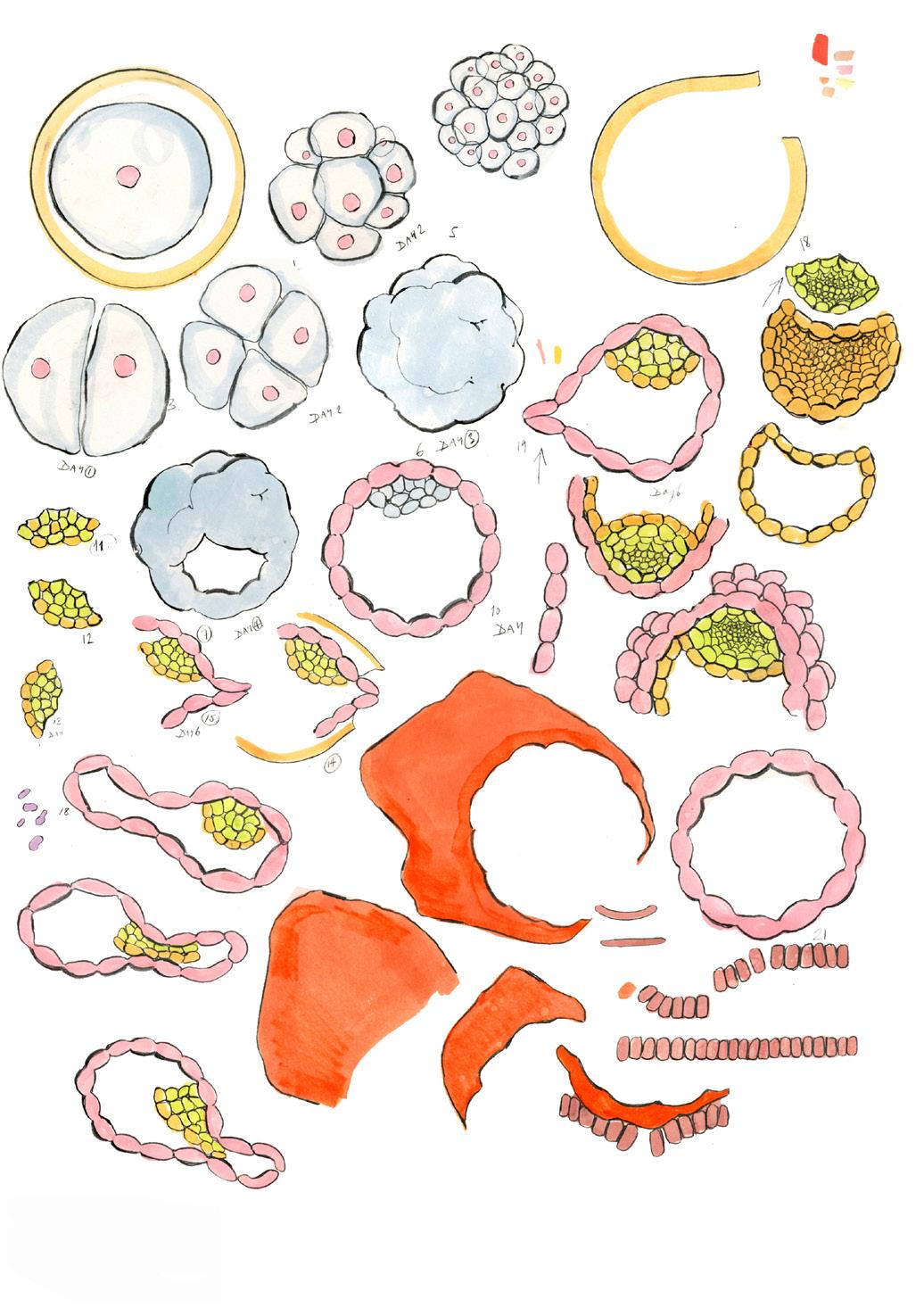 Drawing
Drawn visual shapes for a stop motion animation test. The development of an embryo from conception to day 24.
Drawing
Drawn visual shapes for a stop motion animation test. The development of an embryo from conception to day 24.


